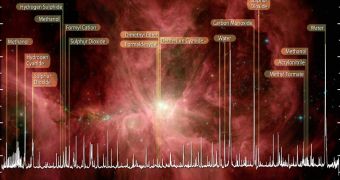Scientists operating the European Space Agency's Herschel Space Observatory announce the discovery of a host of life-enabling molecules in the famous Orion Nebula. The trace signature of these chemicals was discovered through spectral analysis of the light coming in from this particular location. Herschel is uniquely-qualified for this type of scientific studies, and observing such events so close to our solar system is relatively easy. The Nebula itself is also located in our galaxy, the Milky Way, and is considered to be an area of intense star formation, known as a stellar nursery.
Inside this type of structures, clouds of cosmic gas and dust conglomerate do form the ideal conditions for the development of young, blue stars. Winds from older stars ravage this mix, forcing larger and larger clouds of hydrogen gas to form. Eventually, under their own, these clouds fall on themselves, igniting in the process. Scientists say that this is the primary method through which new stars are born, and add that the dimensions of the finished “product” are dependent on the size of the initial cloud that formed them. From time to time, exploding supernovas spread out the gas, further promoting the stellar formation rate in the nursery.
The new datasets were collected using the HIFI (Heterodyne Instrument for the Far Infrared) apparatus aboard Herschel. The telescope carries only three scientific instruments, but each of them is revolutionary in its own way. HIFI, for example, is a spectrometer that can operate in two sets of wavelengths (157 to 212 micrometers and 240 to 625 micrometers), and can also separate radiation of different wavelengths, thus producing a highly-detailed spectral map of the light source it's investigating. It was put to good use on the Orion Nebula because experts knew that this was one of the most prolific chemical factories in the known Universe.
However, astrophysicists admit that they are still very much in the dark as to exactly how these molecules form. The entire process seems to be extremely complex, and the new Herschel data will likely provide at least some understanding of the basic reactions involved. Preliminary analysis of the spectral map the telescope sent back revealed traces of molecules that would eventually enable to formation of life-sustaining chemicals, such as water, carbon monoxide, formaldehyde, methanol, dimethyl ether, hydrogen cyanide, sulfur oxide and sulfur dioxide.
“Herschel is a European Space Agency cornerstone mission, with science instruments provided by a consortia of European institutes and with important participation by NASA. NASA's Herschel Project Office is based at NASA's Jet Propulsion Laboratory, Pasadena, Calif. JPL contributed mission-enabling technology for two of Herschel's three science instruments. The NASA Herschel Science Center, part of the Infrared Processing and Analysis Center at the California Institute of Technology in Pasadena, supports the United States astronomical community. Caltech manages JPL for NASA,” say experts at the JPL.

 14 DAY TRIAL //
14 DAY TRIAL //